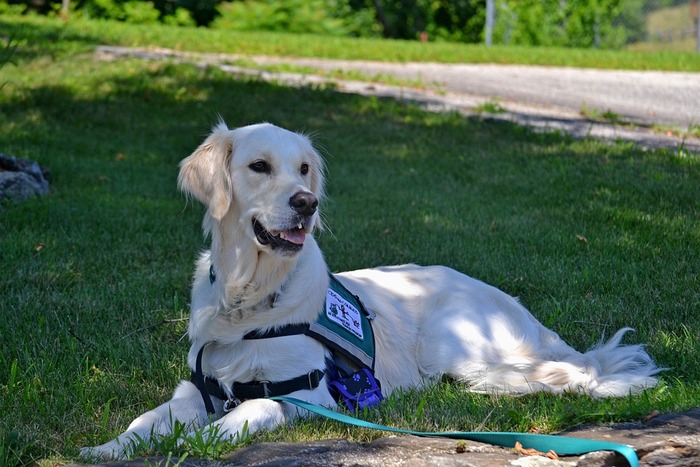
People with physical and/or mental disabilities need to overcome many challenges in their lives. The willingness to feel accepted by those close to you as well as society in general, causes many people worldwide to consider alternatives to standard medication and supporting aid. Service animals are among these types of “alternatives”, that proved extremely helpful to a lot of disabled individuals. Obtaining a service dog is not an easy process though. It is accompanied by many factors that need to be considered by people who have taken the decision to go that way. Money, of course, is one of those factors, that play an essential role.
The nature of service animals, especially their training, and the money you may (not) need to invest, are the main topics that we will discuss in today’s article.
Service Animals- Definition
Probably you are already quite familiar with this term. However, we will clarify it for those of you who are new here. Service animals are dogs who go through individual training to perform tasks directly related to a person’s disability. This disability can be both physical and mental. Except for some U.S. states, which also include miniature horses in the definition of service animals, these animals are limited to dogs only.

Service Animals vs Emotional Support Animals vs Pets
As clarified in the paragraph above, service animals (dogs) do specific work to help alleviate the symptoms of physical or mental disabilities. They are deemed medical equipment and businesses must grant them access to their premises. The “no pet” policy that some facilities may run, does not apply to them.
Emotional support animals (ESA), unlike service dogs, do not perform specific tasks that are directly related to a disability. Through their presence, they provide comfort to a person with a disability. The species that can become ESAs are not limited to dogs only but can be all types of domesticated such as rabbits, guinea pigs, birds...etc. These types of animals do not go through specialized training and are treated as pets while in public. This means, that they can be excluded from public premises, as they are not considered medical equipment. You may think that ESAs are actually just pets since they do not go through specific training and are not treated specially. You are partially correct. In order to turn your pet into an ESA, you need to have a medical letter that verifies your need for an ESA. Also, these animals are protected in the US under the Fair Housing Act, which requires landlords and any housing providers to guarantee them accommodation rights.
Who Qualifies for a Service Animal?
People who have a physical and/or mental impairment that substantially limits one or more major life activities are eligible for a service animal. According to the Americans with Disabilities Act (ADA) people who have a record of an impairment (even if they do not have an impairment at the moment) as well as individuals who are regarded as having an impairment, are considered disabled and thus eligible for a service animal.
There are legal regulations on the minimum age at which a person can be a service dog handler. These regulations vary on a local level and can include the age between 14 and 18 years old.
We need to clarify that a service dog user (the individual who benefits from the service dog tasks) and the service dog handler (the person who handles the dog and has been actively engaged in the training process) can be the same person or different people. It is essential for a service animal to be under the control of the handler at all times while in public. Otherwise, he/she can be excluded from the public setting.

What Tasks Can Service Animals Perform?
The tasks that a dog can be trained to perform as a service animal can vary depending on the person’s disability and needs. The tasks can be related to physical disabilities or mental impairments. Some common types of service dog tasks are:
-Guiding tasks;
-Mobility/balance tasks;
-Psychiatric tasks;
-Alerting tasks;
-Retrieving tasks;
-Interactions tasks;
-Environmental tasks
Service dog tasks can be divided into different categories and feature various activities. You can read more about the tasks that service animals can perform in the following articles: “Service Dogs Tasks” and “Top 10 Psychiatric Service Dog Tasks (& Skills)”.
Service Dog Requirements
There are no limitations on service dog breeds or on what types of dogs can become service animals. However, if you are based in a country, that has banned certain dog breeds, then these won’t be able to be trained as service animals. Dogs must be at least at the age of 6 months to be recognized as service animals (some airlines are likely to accept service animals at the age of 4 months, while others at the age of 7 months). Service animals need to have a calm demeanor, and friendly personality, be intelligent, and people-oriented, and also be trainable. Too stubborn, anxious, and shy dogs or dogs who have the tendency to show aggression are not a good option.

How Much Does It Cost to Have / Get a Service Dog?
Let’s talk about another important aspect of having a service animal-money. Since service dogs are considered medical equipment and not pets, people should have free access to them or at least should not have to pay a lot of money to get one. This is not exactly the case, regardless of how reasonable it may sound. There are several ways to get a service animal and the option you opt for, will also determine the cost.
Getting a Trained Service Dog from a Training Organization/School
Going that way will ensure that you will have an already fully trained service dog. By “fully trained” it is meant that the dog has gone through basic obedience and specialized service dog training and can perform specific tasks. An obvious advantage of this option is that you won’t have to engage in training a dog during the first 2 years of his/her life (2 years is typically the time needed by organizations to fully train a service animal). Also, you will know that the service animal who will be provided to you, was handled by professionals.
The disadvantages of this option are related to different factors, especially costs. Getting a trained service dog can be prohibitively expensive, and the costs can reach up to $30,000. Some organizations offer the option for fund-raising through different platforms.
A second important aspect of getting a trained service dog is that neither the service dog user nor the service dog will have spent much time with each other. This means that a period of adapting will follow, which will also require the person to learn how to handle the dog and interact with him/her. Usually, training organizations that provide trained service animals provide ongoing support to help the future handler learn how to properly manage the dog.
People who get a trained service animal do not have the opportunity to adapt the training process to their needs. These may deviate in some aspects from the certain tasks the dog has been trained to do.
Getting a Trained Service Dog from a Non-Profit Organization
The main difference between this option and the one listed above is the cost of course. Receiving a service animal from a non-profit organization will spare you a lot of money and may need to only pay an application fee between $20 and $50. The big disadvantage here is the long waiting lists. You may have to wait a year or several years to get a trained service animal. Since people with disabilities need the assistance of a service animal as soon as possible, waiting for a dog for a few years often turns out a deal-breaker.
Getting Your Dog Trained With a School/Organization/Trainer
A third option to have a service dog is to get a dog and let him/her get trained by a professional school/organization or hire a professional trainer. This option will cost you less than the first one, but it still can be very expensive. Based on the training program, its duration, or how busy the schedule of the trainer is, you still may need to pay thousands of dollars. This option also has advantages though, i.e. you will rely on professionals to train your dog, and you will be able to choose a training program or discuss a training schedule with a trainer, that suits your needs. Also, you will be more engaged in the training process compared to the first option. If you opt for that option, you should do a research and find an organization whose values and training approach match yours. Getting informed about the requirements for dogs (i.e. age or breed restrictions) to be accepted in the program; the costs; the need for you to participate in the lessons; the terms and conditions of the company...these are among the important factors you should consider when enrolling your dog in a program or hiring a professional trainer.
Self-Training a Service Dog
The number of people who have decided to train a dog themselves, increased in the past few years. This tendency is associated with different aspects, and costs are one of them. Going that way means that you won’t have to pay thousands of dollars for hiring professional trainers, or enrolling in training programs. However, it also means that you need to be very committed to the process and show patience, discipline, and persistence. Training your own service dog is associated with time and effort, which not all people are ready to invest in. There are many online materials both paid and free to use, which can help you understand the main concepts of training your own service dog.
Owner/self-training programs have proved a good option for people who can invest time and put effort into the training process, but who also want to have access to structured lessons and support from trainers (often online). The costs may vary, but usually, they do not exceed a few hundred dollars. You will be able to set your own pace and entirely adapt the training to your needs and your dog’s personality. An important thing to remember, if you would like to train your dog yourself, is to check the local laws. If you are based in the US, the UK, the Netherlands, or another country that recognizes owner-trained service animals, this option might really be the right fit for you. If the laws in our country require service animals to be professionally trained, you still can train a dog yourself, but you won’t be able to visit public places with him/her.
Service Animal Certification and Registry
As we have already mentioned in several of our articles, service animals in the US and the UK are not required by law to be registered or certified. Moreover, there is no official service dog registry approved by a government agency. Buying a certificate or any service animal documentation won’t provide your dog with any access rights. However, if your dog has completed a training course and has been issued a certificate, then you can use this as proof of training.













